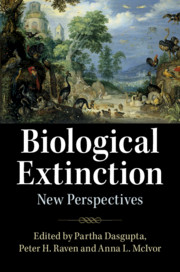Book contents
- Biological Extinction: New Perspectives
- Biological Extinction: New Perspectives
- Copyright page
- Dedication
- Contents
- Figures
- Tables
- Contributors
- Preface
- Acknowledgements
- Introduction
- Prologue
- 1 Extinction in Deep Time
- 2 Biodiversity and Global Change
- 3 The State of the World’s Biodiversity
- 4 Extinction Threats to Life in the Ocean and Opportunities for Their Amelioration
- 5 Out of the Soil
- 6 The Green Revolution and Crop Biodiversity
- 7 Population
- 8 Game Over?
- 9 Why We’re in the Sixth Great Extinction and What It Means to Humanity
- 10 The Consequences of Biodiversity Loss for Human Well-Being
- 11 Terra Incognita
- 12 How Do We Stem Biodiversity Loss?
- 13 Can Smart Villages Help to Stem Biodiversity Loss?
- 14 The New Design Condition
- Index
- Plate Section (PDF Only)
- References
14 - The New Design Condition
Planetary Urbanism + Resource Scarcity + Climate Change
Published online by Cambridge University Press: 19 August 2019
- Biological Extinction: New Perspectives
- Biological Extinction: New Perspectives
- Copyright page
- Dedication
- Contents
- Figures
- Tables
- Contributors
- Preface
- Acknowledgements
- Introduction
- Prologue
- 1 Extinction in Deep Time
- 2 Biodiversity and Global Change
- 3 The State of the World’s Biodiversity
- 4 Extinction Threats to Life in the Ocean and Opportunities for Their Amelioration
- 5 Out of the Soil
- 6 The Green Revolution and Crop Biodiversity
- 7 Population
- 8 Game Over?
- 9 Why We’re in the Sixth Great Extinction and What It Means to Humanity
- 10 The Consequences of Biodiversity Loss for Human Well-Being
- 11 Terra Incognita
- 12 How Do We Stem Biodiversity Loss?
- 13 Can Smart Villages Help to Stem Biodiversity Loss?
- 14 The New Design Condition
- Index
- Plate Section (PDF Only)
- References
Summary
It is the confluence of three human agency trends – planetary urbanism, resource scarcity and climate change – that will have a profound impact on the manner in which we occupy and relate to the planet and each other. This confluence is unparalleled in world history. We are entering unknown territory with little knowledge as to how these three trends will interact in complex, unpredictable and unprecedented ways. However, we do know that this confluence is upon us and it will continue to create a NEW DESIGN CONDITION to which we as a planetary community need to respond.
- Type
- Chapter
- Information
- Biological ExtinctionNew Perspectives, pp. 405 - 423Publisher: Cambridge University PressPrint publication year: 2019



